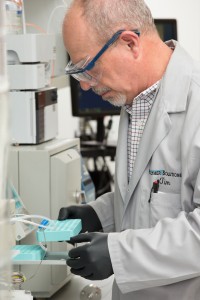Virtually everything that’s made and sold commercially — from medical devices and medications to floor mops and fan blades — undergoes some form of testing to develop, improve and monitor that product’s performance. However, testing takes resources, time and money, so it’s imperative for manufacturers of every stripe to conduct exactly the right tests in the optimum manner to ensure their products are safe and effective.

That’s where the ASTM International, a global standards development organization, comes in. Founded in 1898 as the American Society of the International Association for Testing and Materials, it’s the oldest such standards organization and now publishes more than 12,500 consensus standards for a huge range of products, systems, services and materials in 90 industry categories — including polymer testing. The 30,000 members of the ASTM are from more than 140 countries, and represent 90 percent of the world’s population, according to the ASTM website.
ASTM Committee D20 on Plastics. The drive for developing these standards is attributed to declarable substance guidelines such as ROHS and the drive to have phthalates removed from children’s toys.”
What are ASTM standards?
An ASTM standard is a document that formalizes procedures, rules or guidelines for an industry to follow to develop, evolve and test its products, services and procedures. To become a standard, the procedure must meet ASTM requirements.
How are ASTM standards created?
ASTM standards are generally created by experts within a general category (Polymers). Standard development is started when there is a need to normalize testing between vendors and buyers. It provides a common language on testing. Standard creation can be initiated by industry need, consumer demands, or government regulations. For instance there is a focused effort to determine phthalate plasticizers in PVC materials within ASTM Committee D20 on Plastics. The drive for developing these standards is attributed to declarable substance guidelines such as ROHS and the drive to have phthalates removed from children’s toys.
Who governs ASTM standards?
A society of experts is in charge of creating and maintaining ASTM standards. ASTM copyrights the standards and makes them available for purchase. These standards are required to undergo a five year review to remain active.
How does one get to participate in developing standards?
It helps if you have a relevant technical background, but it’s not required. Anyone with an interest in helping develop standards can volunteer.
Who decides what processes or products ASTM will develop standards for?
ASTM standard development is left to the relevant committees. Generally, at ASTM meetings individuals will bring idea, comments, or issues to the appropriate subcommittee/section meeting for discussion. If the concern if found to be technically relevant the subcommittee chair will approve and a work item will be initiated. There will be a lead technical contact and this person will have the option to start a collaboration area to work with others interested in the project. Within the Plastics committee, we have seen substantial growth in the interest in biodegradable materials and recycled plastics.
How do ASTM standards help the world in general and the field of polymer science in particular?
ASTM standards provide a common language across an industry (polymers for example). In order to compare test data, we need to make sure everyone is running a specific test in the same manner. This allows us to compare results between a supplier and a purchaser, or to compare the technical attributes amongst potential materials for an application (what material should we use in a dishwasher gear). It is a platform where a wide cross-section of an industry can come together and create technically relevant testing procedures.

Since the ASTM is a consensus organization, everyone’s concerns are taken into consideration during the creation or review of an ASTM standard. Anyone can participate in an ASTM committee. However, in order to contribute effectively to the group, you must understand the industry and materials related to it.
The direction of standards development is also guided by an Advisory Subcommittee for each division (such as Committee D20 on Plastics), which serves as a group similar to a board of directors.
